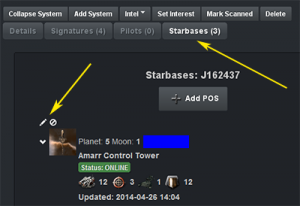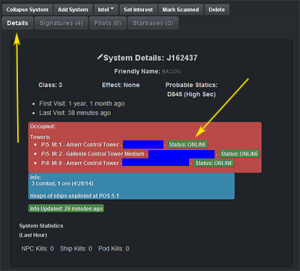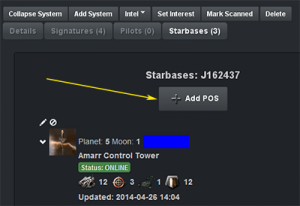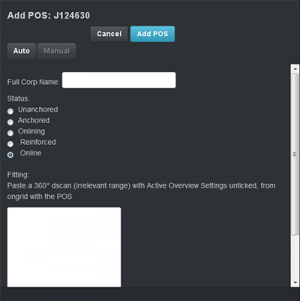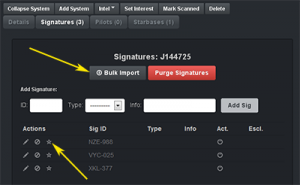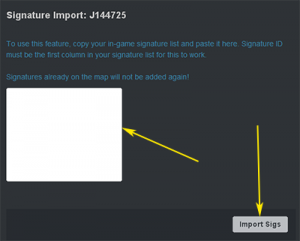Difference between revisions of "Wormhole Community Scouting Guide"
| Line 93: | Line 93: | ||
===Gathering new POS intel - part 2=== | ===Gathering new POS intel - part 2=== | ||
| − | [[File:Tracking camera.png|right | + | [[File:Tracking camera.png|thumb|right|''image 1'' - Tracking camera button]] |
| − | [[File:Tracking camera center.png|right | + | [[File:Tracking camera center.png|thumb|right|''imgage 2'' - Center tracking camera button]] |
If you have found one or more new active POSes in the system in part 1 above, you can use the following steps to pinpoint them: | If you have found one or more new active POSes in the system in part 1 above, you can use the following steps to pinpoint them: | ||
#If the planet cluster containing a new active POS has only 1 or 2 moons, you can warp to each moon (at 10) and see if the POS is there. Once you find it, skip down to the [[Wormhole Campus Scouting Guide#Adding new POS intel to the mapper|Adding new POS intel to the mapper]] section, otherwise continue on | #If the planet cluster containing a new active POS has only 1 or 2 moons, you can warp to each moon (at 10) and see if the POS is there. Once you find it, skip down to the [[Wormhole Campus Scouting Guide#Adding new POS intel to the mapper|Adding new POS intel to the mapper]] section, otherwise continue on | ||
Revision as of 14:04, 29 April 2014
Welcome WHC Scouts!
If you are reading this, you are probably a newer member of the WHC who is an explorer at heart. You might even be interested in being a scout for the campus but are not sure of all the little intricacies of scanning/scouting down our chains in hopes of finding PvP and even PvE activities. If we have your attention so far, please read on :-)
This guide will take you step by step through the preferred process of scanning and scouting down one of our new chains, including what to do should you find potential PvP targets.
Also keep in mind that there are certain scenarios that might not be covered in this guide. However, scheduled and impromptu new WHC scout training sessions are available, organized by the campus Education Officers, currently Hannah Onasi and Kaliano. These sessions will cover topics in this guide as well as any other scenarios that might come up from time to time - so don't force yourself to memorize this entire guide :-)
This guide has the following general structure:
- Jumping into a new system, bookmarking the way home, adding the system to the mapper and gathering initial intel (d-scan)
- If no visible threat is present
- Confirming current mapper intel (active POSes)
- Gathering new intel (new active POSes)
- Adding new active POSes to the mapper
- If there are signs of activity in the system (ships, wrecks etc.) on d-scan
- Locating any active pilots
- If there are potential PvP targets (site-runners, miners, gas huffers, roaming gang picketing a hole etc.), conveying that information (including their exact location, ships and pilots) to the rest of the fleet
- Getting a good warp-in point on the targets for the fleet
- Enjoying the action! (remember to have a drone or some EWAR on your scanning ship to get on the kill mails)
- After the system is clear or once it is apparent that we have an overwhelming presence, continuing to gather intel
- If no visible threat is present
Helpful links
Wormhole Scouting <--- read this when you have some free time but continue reading the page you're currently on for WHC specific guidelines
Helpful terms
- POS: Player Owned Starbase
- Active POS: a POS which has a force field (also "online")
- POCO: Player Owned Customs Office
First Steps
Let us begin with a new cosmic signature appearing in our home system.
Let's assume that it is in fact a new wormhole and you have just probed it down to 100%.
Let's also assume that this is a new Bacon static. Eggs and other dynamics off of Innuendo as well as other systems down the chain are handled similarly.
Note:All bookmarks should be placed in the Wormhole Campus folder of the Corporation Bookmarks unless otherwise stated. Keep in mind that corporate bookmarks can take up to 5 minutes to propagate (show up) for everyone else in the corporation.
- (Optional but helpful) Announce that you have scanned down the new Bacon and are in warp to it
- Warp to the wormhole at 10 (warping at zero will de-cloak you and make you visible to someone possibly jumping in from the other side)
- Bookmark the wormhole once on grid (following the bookmarking scheme linked at the top of this page) - DO NOT bookmark any wormhole from the scanner window as the bookmark may be up to 5km off the actual location
- Announce in mumble and/or in fleet chat that you are on grid with the new Bacon so that others wanting to help scan down the new chain can join you immediately, without having to wait for the bookmark to propagate. You can put something like "www new bacon" in fleet chat
- Once everyone wanting to join you is in warp, go ahead and jump in - always announce friendly activations :-)
I'm in Bacon!...now what?
Keep your presence to yourself
One thing that cannot be overstated is the importance of not announcing your presence to anyone in the system you just jumped into (until you are ready to - more on this later). In other words:
- Do not drop your probes as soon as you jump in
- Do not de-cloak and sit on the hole and in general, do not be de-cloaked unless absolutely necessary; like when landing on a hole that you're about to jump into. People flying T1 scanning frigates can be excused so they can still practice scanning and scouting but are encouraged to train into covops if they plan on being serious scouts
- Do not talk in local
Initial steps and intel
Now that we have that out of the way, let's go step by step (assuming there are no visible hostiles on grid with you)
- Quickly push away from the wormhole and immediately cloak back up (as soon as you're cloaked again, you can stop your ship so you're still close enough to jump back quickly if you have to)
- Bookmark the way back home
- Add the new system to the mapper (see the WHC Mapper link at the top of this page)
- Announce (preferably in mumble) that you have done the above two steps
- Check d-scan for the presence of any ships, wrecks, deployable mobile structures (mobile depots, mobile tractor units, etc.), active POSes (force fields)
Confirming current mapper POS intel
At this point we are still assuming that there are no apparent threats in the system (no ships visible on d-scan - at least not from the hole). The next thing you should do now is gather some additional intel on the system:
- Open up the mapper and click on the newly added Bacon system
- You should be on the "Details" tab by default which will show system occupancy, if any (POSes in the pinkish box) - see image 2 on right
- Take note of any POSes with the "Status: ONLINE" tag - see image 2 on right
- Warp to each listed active POS' moon at 10 (warping at zero means warping to the most common warp-in point and warping at a greater distance such as 100, might land you close enough to a POS module and de-cloak you...I have warped to 100s of POSes and have only been de-cloaked by a POS module once, at that was when I warped to the moon at 70)
- Confirm whether the POS is still in fact there (and if it's still online or now only anchored)
- If the POS is completely gone, delete it from the mapper by clicking the little circle with a slash icon next to the POS in the "Starbases" tab - see image 1 on right
- If the POS is still there but only anchored, change that designation by clicking the little pencil icon next to the POS in the "Starbases" tab and changing the "Status" - see image 1 on right
- Do a d-scan at 1 AU and 360 degrees before you warp off to see if there are any other active POSes at your current planet - especially if the mapper shows that there should be a POS at your location but you don't see one. Often the corp will move their POS to another moon at the same planet. If this is the case, you'll learn how to add a new POS to the mapper in the Adding new POS intel to the mapper section below
- Once you have done the above for each listed active POS, you are ready to check the rest of the system for any new inhabitants
- Keep d-scanning as you perform the above steps!
Gathering new POS intel - part 1
Now let us check if there are any new inhabitants (active POSes) in the system:
- If this is a small system and everything is on d-scan and you are sure that there are no new active POSes present, you can continue on to the Signature Scanning section below. Otherwise:
- Warp at range to a customs office somewhere at the core of the system. POCOs at planets I or II are good candidates. The reason you should warp at range to a POCO and not a planet is that warping to a planet at range can sometimes land you close enough to a POCO to de-cloak you. Not all planets have POCOs in which case just warp to the planet itself at distance
- D-scan (max range and 360 degrees) and check for force fields
- Take note of any force fields and control towers which you already confirmed in the previous section (Confirming current mapper POS intel) and ignore them
- If you find that there are other active POSes which are not in the mapper, there are a couple of ways that you can find them but here is one:
- Open up your Solar System Map (F10)
- Take note of any planets that are outside of d-scan range (14.3 AU). You can ignore planets that have no moons
- The camera pivot point should be centered on your current location but just in case, double click something on the map that is right on top of you (planet, bookmark etc.)
- Align your current location (like a gun sight) with planets within range and do a max range d-scan at 5 degrees
- Take note of any planet clusters that have active POSes
- Repeat steps 5.4 & 5.5 for all planets with moons within d-scan range
- Now warp to each of the out of d-scan range planets (remember, warp to POCO at distance) that you noted in step 5.2 and repeat the d-scanning process until you have covered the entire system
At this point you should have the general location of all new active POSes in the system. Now it's time to pinpoint their exact locations in part 2 below
Gathering new POS intel - part 2
If you have found one or more new active POSes in the system in part 1 above, you can use the following steps to pinpoint them:
- If the planet cluster containing a new active POS has only 1 or 2 moons, you can warp to each moon (at 10) and see if the POS is there. Once you find it, skip down to the Adding new POS intel to the mapper section, otherwise continue on
- If the planet has a lot of moons (let's say 10 or more) and only one new active POS, you can eliminate half of the moons in the following way:
- In an overview tab which shows moons as well as force fields, find the moon that is roughly halfway (in distance) between the closest and furthest moon
- Let's say the "middle" moon is 500,000km away and the next one is at 600,000km
- Do a d-scan at a distance between the "middle" moon and the next one (550,000km should be fine in this case) at 360 degrees and see if it picks up the force field
- If it does, you can eliminate any moon further than the "middle" moon. If it does not, you can eliminate the "middle" moon and any other moon that is closer. You can continue to eliminate moons this way until you have narrowed it down to just a couple, at which point you can find the new POS quickly by just warping to your candidates. Once you have found it, skip down to the Adding new POS intel to the mapper section
- If the planet has many moons and more than one new active POS (or you just don't like the above "elimination" method in step 2):
- Warp at distance to the POCO of the planet in question
- Turn on your tracking camera (default "c") or use the button on your HUD - see image 1 on right
- Make sure the tracking camera is centered on your ship - see image 2 on right
- Turn on the special bracket display via "Shift Alt X" - this will turn on moon brackets in space, regardless of what other brackets you may or may not have turned on
- Select a moon in either your overview or in space and do a 5 degree close range (1 AU) d-scan and see if you pick up a force field - do this for all the moons of the planet in question and note where each active POS is located
- Now you are ready to finally add the POS(es) to the mapper in the next section \o/
Adding new POS intel to the mapper
- The easiest way to add a new POS is in "Auto" mode. To do this, you need to be on grid with the POS
- Fill in the POS details
- Make sure that you are in the right system in the mapper and click the plus button in the "Starbases" tab - see image 1 on right
- See image 2 on right for the following steps
- The Auto/Manual selection should be on "Auto" by default - leave it at that
- Fill in the "Full Corp Name"
- You can show info on the control tower, then click on the corp icon to show info on the corp that owns it
- Drag the corp icon from the show info window into any chat window and simply copy/paste that corp name into the "Full Corp Name" field
- You can also just type in the corp name yourself but using the two steps above can be easier and more accurate
- Select the "Status" - we usually only add "Online" POSes
- In the "Fitting" window, paste a 360 degree d-scan (irrelevant range - as long it covers the POS and nearby moon) with "Active Overview Settings" un-ticked
- Click the blue "Add POS" button and you're done
- Continue d-scanning for ships, wrecks etc. as you go through the above steps!
- Sometimes you may get an error trying to add a POS in Auto mode, at which point you can add it manually. If this happens, it would be helpful if you file a bug report. Please include all the details you entered.
- Fill in the POS details
- Click the "Manual" button
- Fill in the "Full Corp Name" as above
- Also fill in the other info - not shown in the image - (Planet, Moon, Tower Name, Tower Type)
- Select the "Status" as above
- Fill in the "Fitting" as above but make sure you also tick the "Parse as D-Scan Paste" checkbox at the bottom (not shown in the image)
- Click the blue "Add POS" button and you're done
- Continue d-scanning for ships, wrecks etc. as you go through the above steps!
Assuming that you still have not seen any active pilots in the system, you are ready to drop your probes and start scanning down signatures
Signature Scanning
If you are the only person scouting the new system or if no one else has already done this, import all the Cosmic Signatures into the mapper:
See the images on the right for the following steps
- In your Probe Scanner window, make sure that Cosmic Signatures are selected in the drop down and "Show Anomalies" is not ticked
- All that should be showing now are Cosmic Signatures. Click inside the list of signatures then Ctrl A and Ctrl C to copy them all
- Open up the mapper, make sure you are in the correct system (click on it to be certain) and click on the "Signatures" tab
- Click the "Bulk Import" button and Ctrl V to paste the signatures into the window and click the "Import Sigs" button
- Find a safe place to drop your probes - (Not on a wormhole, at a POS or at the Sun)
- Start scanning - remember to click the little star next to the signature that you're working on in the mapper to "own" it. This will turn it green and alert others not to scan it also - see image 1
- Always bookmark wormhole connections in every system. If you find Data, Relic or Gas sites and you are in Bacon or Innuendo, bookmark them all in the Wormhole Campus corp bookmarks folder using the WHC Bookmarking Scheme. In any other system, only bookmark wormhole connections. The only exception to this are Vital and Instrumental Gas sites in C5 and C6 systems, as these contain the expensive gas that we often like to huff.
- Besides bookmarking, it is also important to add each signature's "Type" and "Info" to the mapper. If this is Bacon or Innuendo, enter both the "Type" and the "Info" and in any other system only the "Type" is needed. This means that you only have to get a 25% hit to get the "Type". C5 and C6 Gas sites need to be scanned down to at least 75% so that the exact site info is known and should it be a Vital or Instrumental, then it is necessary to scan it down to 100% in order to bookmark it.
- Note on "claiming" new wormhole connections: if you scan down a new wormhole connection, immediately warp to it and show info on it (which will tell you where it leads). Then check the mapper to see what the next system should be called (based on whether it leads to high/low/null sec or w-space) and announce that you are claiming this new system - in mumble, fleet chat or both. This helps to prevent others adding new systems to the mapper with duplicate names.
Once you are done with the current system and are ready to jump through a new connection:
- Always note the state of the connection before jumping through and adding it to the mapper
- Check the "lifetime" text - if it is "end of life" consider not jumping as you may get stuck on the other side. In this case you can add "EOL" to the end of the bookmark name to alert others. If you are not jumping through, you can enter "WH [where it leads to] EOL" in the "Info" box of the signature in the mapper
- Check the "mass" text - if it is critical and on the verge of collapse, consider not jumping as you may collapse it on your way out...even in a frigate. You can also add "CRIT" to the end of the bookmark to alert others and make a similar note in the mapper as in the above step
- If the connection is not EOL or mass critical, note the wormhole ID (so you can enter it when you add the new system - this will show the connection mass on the mapper which is very important as we plan what types of ships we can take through it before it collapses), jump through and repeat the whole process in this guide
